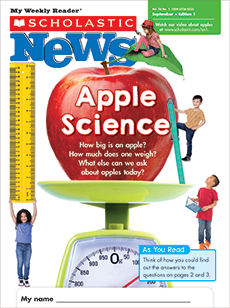Academic Standards
Learning Objective:
Children will discuss what good citizens do.
Social and Life Skills Focus:
social awareness
Page 4 Skill:
read a map
Vocabulary:
citizens, tidy
CCSS:
RI.1.1 ask and answer questions; RI.1.4 determine meaning of words; RI.1.10 read informational texts; RF.1.1 punctuations; RF.1.2 syllables; SL.1.1 participate in collaborative conversations
Watch the video
Watch the video
Build background knowledge about being a good citizen by watching “Good Citizens.” When you’re done watching, ask the following question: What is one way you can be a good citizen?
Preview new vocabulary words
Preview new vocabulary words
Project the online vocabulary slideshow and introduce this issue’s featured words.
Set a purpose for reading
Set a purpose for reading
- Have students do a picture walk through the issue, then read and discuss the cover. Ask students to give a high five to a partner in the class.
- Then, before turning to page 2, say, “As we read the article, think about what good citizens do."
- As you read, pause after each box. Are students ready to do what good citizens do? Encourage students to high five a partner in agreement.
- When you’re done reading, ask children to turn and talk to a partner about what they read. Which parts of being a good citizen might be hard? How can they still do it? Tell students to make sure they follow what they learned in the Talk About It sidebar!
- Reading Checkpoint (skill: reading comprehension)
- Pick the Punctuation (skill: punctuation)
- How Many Syllables? (skill: syllables)
Play the online game: School Search and Find
(skill: vocabulary)
Complete a hands-on activity: We Are Classroom Citizens
As a class, create a list of what good citizens do. Then have everyone take turns signing the official classroom citizen document with their handprint! (skill: responsible decision making)
Read a paired text
In Wordy Birdy by Tammi Sauer, a chatty bird has a hard time listening, even when her friends have something important to say! Students will love the hilarious trouble Wordy Birdy gets into and appreciate how her friends never give up on her.
